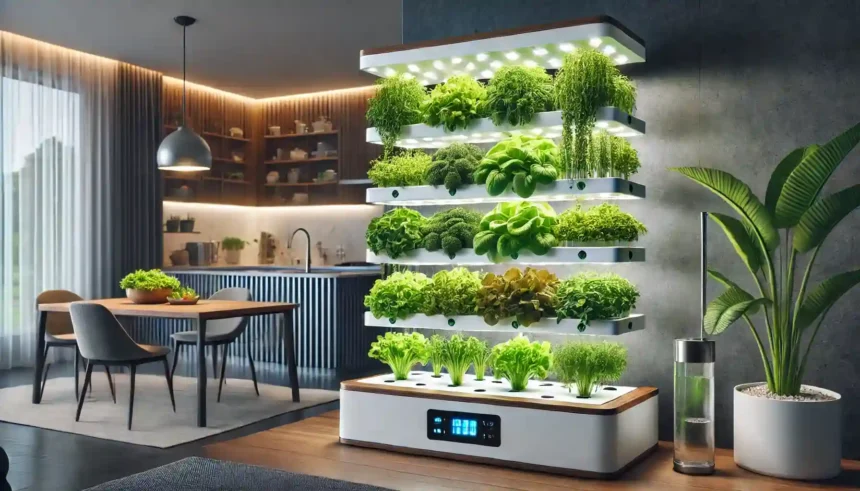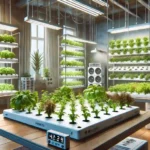As more people look for sustainable ways to grow their own food, home hydroponics has emerged as a popular and efficient method for indoor gardening. By using a soil-free system, hydroponics allows you to grow a wide variety of plants indoors, regardless of the season. Here’s how you can start growing your own food with a home hydroponic system.
“Hydroponics is not just about growing plants without soil; it’s about growing plants faster, cleaner, and more efficiently.” – Unknown
What is Home Hydroponics?
Home hydroponics is a method of growing plants without soil, using nutrient-rich water instead. This system allows plants to absorb essential nutrients directly from the water, leading to faster growth and higher yields compared to traditional soil-based gardening.
Key Components of a Hydroponic System
- Water Reservoir: Holds the nutrient solution that feeds the plants.
- Growing Medium: Supports the plants’ roots, often made from materials like coconut coir, perlite, or clay pellets.
- Nutrient Solution: A mix of water and essential nutrients tailored to the needs of the plants.
- Light Source: Provides the necessary light for photosynthesis, often using LED grow lights for energy efficiency.
- Air Pump: Ensures proper oxygenation of the water, which is crucial for root health.

Benefits of Growing Your Own Food Indoors with Hydroponics
Growing food indoors using hydroponics offers numerous advantages over traditional gardening methods.
Space Efficiency
Hydroponic systems are ideal for small spaces, making it possible to grow a significant amount of food even in apartments or urban environments.
- Vertical Gardening: Use vertical hydroponic systems to maximize space and grow more plants in a limited area.
- Compact Systems: Many hydroponic setups are compact and can fit on countertops, shelves, or small balconies.
Faster Growth and Higher Yields
Plants grown in hydroponic systems often grow faster and produce higher yields due to the efficient delivery of nutrients.
- Direct Nutrient Absorption: Plants receive nutrients directly from the water, leading to quicker growth compared to soil-based gardening.
- Controlled Environment: Indoor hydroponic systems allow you to control temperature, humidity, and light, creating optimal growing conditions year-round.
Water Conservation
Hydroponics uses significantly less water than traditional soil gardening, making it an eco-friendly option.
- Recirculating Systems: Many hydroponic systems recirculate water, reducing waste and conserving resources.
- Efficient Water Use: Water is delivered directly to the plant roots, minimizing evaporation and runoff.
Pesticide-Free Growing
Indoor hydroponic gardening reduces the need for pesticides and herbicides, leading to cleaner, healthier produce.
- Controlled Environment: Growing indoors limits exposure to pests and diseases, reducing the need for chemical interventions.
- Organic Options: Many home gardeners choose to use organic nutrient solutions, ensuring their food is free from synthetic chemicals.
Setting Up Your Home Hydroponic System
Getting started with home hydroponics is easier than you might think. Here’s a step-by-step guide to setting up your system.
Choose the Right System for Your Space
There are several types of hydroponic systems, each with its own advantages. Choose one that suits your space and growing needs.
- Deep Water Culture (DWC): Ideal for beginners, DWC systems are simple to set up and maintain. Plants grow in a nutrient-rich water reservoir with their roots submerged.
- Nutrient Film Technique (NFT): NFT systems are great for growing leafy greens and herbs. A thin film of nutrient solution flows over the plant roots, which are housed in channels.
- Drip System: In a drip system, nutrient solution is delivered directly to the plant roots via a network of tubes. This system is versatile and works well for a variety of plants.
- Aeroponics: Aeroponic systems suspend plant roots in the air and mist them with nutrient solution. This method provides excellent oxygenation and is suitable for advanced growers.
Select Your Plants
Choose plants that are well-suited to hydroponic growing. Some popular options include:
- Leafy Greens: Lettuce, spinach, kale, and arugula thrive in hydroponic systems and are quick to harvest.
- Herbs: Basil, mint, cilantro, and parsley grow well indoors and add fresh flavor to your cooking.
- Tomatoes: With the right setup, you can grow juicy, flavorful tomatoes year-round.
- Peppers: Both sweet and hot peppers are well-suited to hydroponics and produce bountiful harvests.
Prepare the Nutrient Solution

A balanced nutrient solution is key to successful hydroponic gardening.
- Hydroponic Nutrients: Purchase a pre-mixed hydroponic nutrient solution designed for the specific plants you’re growing.
- pH Balance: Monitor and adjust the pH of the nutrient solution to ensure it remains within the optimal range (usually between 5.5 and 6.5).
- Water Quality: Use filtered or distilled water to avoid contaminants that can affect plant health.
Set Up the Lighting
Adequate lighting is crucial for indoor hydroponic systems, especially if natural light is limited.
- LED Grow Lights: Choose energy-efficient LED grow lights that provide the full spectrum of light needed for photosynthesis.
- Light Timers: Set up timers to mimic natural daylight cycles, typically 14-16 hours of light per day for most plants.
- Positioning: Place lights close to the plants, adjusting as they grow to ensure even light distribution.
Monitor and Maintain Your System
Regular maintenance is essential to keep your hydroponic system running smoothly.
- Check Water Levels: Ensure the water reservoir remains filled and top it up as needed.
- Monitor pH and Nutrients: Regularly test the pH and nutrient levels, adjusting as necessary to maintain optimal conditions.
- Clean the System: Periodically clean the system components to prevent the buildup of algae and other contaminants.

Tips for Successful Indoor Hydroponic Gardening
Start Small and Scale Up
If you’re new to hydroponics, start with a small system to get the hang of it before investing in a larger setup.
- Beginner Kits: Consider purchasing a hydroponic starter kit, which includes everything you need to get started.
- Experiment with Different Plants: Start with easy-to-grow plants like lettuce or herbs, then expand to more challenging crops as you gain experience.
Keep a Growing Journal
Track your progress by keeping a journal of your hydroponic gardening activities.
- Record Growth Stages: Note when seeds germinate, when plants are transplanted, and when you harvest.
- Monitor Conditions: Record the pH, nutrient levels, and any adjustments you make to the system.
- Observe Results: Take notes on what works well and what could be improved for future growing cycles.
Join a Hydroponics Community
Connect with other home hydroponic gardeners to share tips, troubleshoot problems, and learn from their experiences.
- Online Forums: Join online communities like Reddit’s r/hydroponics or gardening forums to ask questions and find resources.
- Local Groups: Look for local gardening clubs or community groups that focus on hydroponics and indoor gardening.
“Growing your own food is like printing your own money.” – Ron Finley, urban gardener
Top Indoor Gardening Tips offers insights into successful indoor gardening practices. For more tips on hydroponics, visit Hydroponic Gardening 101. Discover additional strategies in our sustainable living section. Learn more about growing food indoors with our guide to home hydroponics. For more information on hydroponics, visit Hydroponics Online. To explore the latest in sustainable gardening, check out Modern Farmer. For additional resources, see The Hydroponic Society.














Wonderful beat I wish to apprentice while you amend your web site how could i subscribe for a blog web site The account aided me a acceptable deal I had been a little bit acquainted of this your broadcast provided bright clear idea
I just could not leave your web site before suggesting that I really enjoyed the standard information a person supply to your visitors Is gonna be again steadily in order to check up on new posts
I do trust all the ideas youve presented in your post They are really convincing and will definitely work Nonetheless the posts are too short for newbies May just you please lengthen them a bit from next time Thank you for the post
Thanks for sharing. I read many of your blog posts, cool, your blog is very good.